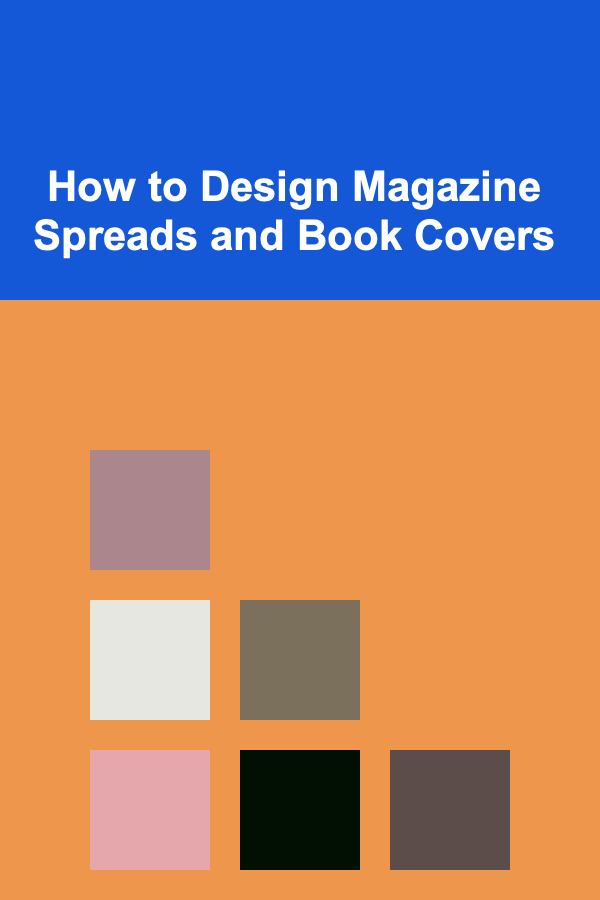
How to Design Magazine Spreads and Book Covers
ebook include PDF & Audio bundle (Micro Guide)
$12.99$7.99
Limited Time Offer! Order within the next:

Designing magazine spreads and book covers is an art that combines creativity, typography, color theory, and an understanding of the target audience. These design elements are crucial in attracting readers, setting the tone, and communicating the content of the publication at first glance. Whether you are working on a magazine layout or a book cover, understanding the principles of graphic design and how to effectively apply them can make your work stand out. In this article, we will explore the processes, tips, and tools that will help you design stunning magazine spreads and book covers.
Understanding the Basics
Before diving into specific techniques, it's important to understand the fundamental elements that go into designing both magazine spreads and book covers.
1. Target Audience
Understanding who the publication is intended for is crucial in determining the design approach. A magazine spread or book cover for a children's story will differ vastly from that of a high-fashion magazine or a scholarly journal. The design should reflect the interests, demographics, and cultural context of the intended readers.
For instance, vibrant colors, playful fonts, and illustrations would work well for children's books, whereas minimalist design, sophisticated typography, and muted colors are often used for high-end lifestyle magazines.
2. Composition
Composition refers to the arrangement of visual elements in the design. This includes the balance between text and images, the use of negative space, and how each element leads the reader's eye through the page. Whether it's a magazine spread or a book cover, composition plays a key role in creating a cohesive and attractive design.
3. Typography
Typography is an essential element in both magazine spreads and book covers. The fonts you choose must complement the overall design and reflect the tone of the publication. For example, serif fonts are often seen as traditional and sophisticated, while sans-serif fonts give a modern and clean look.
4. Color Theory
Color is a powerful tool that can convey emotions, highlight important information, and tie a design together. In the case of book covers, the colors used can give readers a hint of the book's genre or mood. For instance, dark, moody colors are often used for thrillers, while bright, vibrant hues are common in children's books.
Designing Magazine Spreads
Designing a magazine spread involves careful attention to layout, image placement, and typography. A magazine spread is a visual journey for the reader, guiding them through the article or feature. Here's a step-by-step process for designing a professional magazine spread.
1. Start with a Grid System
A grid system is the backbone of any good magazine layout. It helps to organize content and create a balanced, readable spread. Grids are invisible guides that help place text, images, and other design elements in a way that is both aesthetically pleasing and functional. Grids ensure that everything is aligned and consistent throughout the magazine.
There are different types of grid systems you can use, depending on the design requirements:
- Single Column Grids: Ideal for simple layouts, often used in newspapers or basic magazine articles.
- Multiple Column Grids: These grids use several columns to create a dynamic layout. They are often used in magazines to provide flexibility for text and image placement.
- Modular Grids: These are based on a larger grid with subdivided sections. They are often used in more complex layouts, such as those seen in design-focused magazines.
2. Choose the Right Images
In magazine spreads, images are often the focal point. They help break up text and make the article more engaging. Choosing the right images is crucial to complementing the article's content. High-quality, professional images are key.
- Resolution: Ensure that images are of high resolution (at least 300 DPI) to avoid pixelation when printed.
- Relevance: The images should support or illustrate the content. For example, a fashion magazine spread would require well-curated, stylish images that reflect the latest trends.
- Placement: Images should be placed in a way that enhances the flow of the article. Sometimes, large images or photos can serve as a focal point, while others may be used as smaller accents alongside text.
3. Typography and Text Layout
The way text is laid out in a magazine spread is just as important as the images. Text should be easy to read and well-organized, with clear headings, subheadings, and body text.
- Font Choices: Select fonts that are readable and complement the overall aesthetic. A mix of fonts (e.g., serif for headings and sans-serif for body text) can create visual interest, but it's important to maintain harmony.
- Hierarchy: Establish a clear hierarchy of information using font sizes and styles. Headings should be larger and bolder, while subheadings and body text should be smaller and lighter.
- Text Alignment: Justified text can make the layout look clean and organized, while left-aligned text often feels more casual and approachable. Pay attention to how text flows from one page to the next and ensure that it leads the reader naturally through the article.
4. Use of White Space
White space (or negative space) is the empty area between design elements. While it may seem like wasted space, it actually plays a vital role in making the design feel balanced and uncluttered. White space provides breathing room for the eye and helps create a more digestible layout.
5. Design Consistency
Consistency is crucial in magazine design. Consistent use of fonts, colors, grid systems, and layout styles creates a cohesive look throughout the magazine. Readers should be able to easily navigate the publication and understand where the content begins and ends.
Designing Book Covers
Designing a book cover is about capturing the essence of the story and attracting potential readers. A well-designed book cover can spark curiosity, evoke emotions, and entice someone to pick up the book. Here's how to create an effective book cover design.
1. Understand the Genre and Target Audience
The first step in designing a book cover is to understand the genre and audience. A book cover for a horror novel will differ from a romance novel or a non-fiction biography. The colors, typography, and imagery should reflect the mood, themes, and genre of the book.
For example:
- Romance novels often feature soft, warm colors like pinks and reds, with elegant fonts and imagery of couples.
- Mystery or thriller books tend to use darker colors, bold typography, and mysterious imagery, creating a sense of intrigue.
- Non-fiction book covers often lean towards clean, simple designs with bold titles and a professional appearance.
2. Focus on Typography
Typography is one of the most important elements of a book cover. The title should be the most prominent text, followed by the author's name. The typeface you choose should reflect the tone of the book.
- Title Font: The font for the title should be large, bold, and easily readable. Consider using a custom or unique font that fits the book's genre.
- Author's Name: The author's name is typically smaller than the title but still visible. It should be placed in a way that does not detract from the title.
3. Select Powerful Imagery
Imagery is a powerful tool in book cover design. The image should hint at the story's plot, setting, or themes. It should also evoke curiosity or emotion from the reader.
For example, a book about an ancient civilization might feature an image of ruins, while a fantasy novel might showcase mystical landscapes or magical creatures.
4. Use Color to Set the Mood
Color plays a huge role in conveying emotion. For instance, vibrant colors like yellow and orange are associated with energy, while dark colors like black or navy blue evoke mystery or danger. The right color palette can help reinforce the book's tone and appeal to the intended audience.
5. Consider the Spine and Back Cover
When designing a book cover, it's important to consider the spine and back cover as well. The spine should include the book title and author's name so it can be easily identified when shelved. The back cover typically features a book summary or blurb, along with other details like the ISBN, barcode, and publisher's logo.
6. Test the Design at Different Sizes
Book covers are often viewed in small thumbnails, especially online. Make sure the design is clear and legible when scaled down. Text should still be readable, and the imagery should retain its impact.
Tools for Designing Magazine Spreads and Book Covers
There are several tools and software available for designing magazine spreads and book covers. Below are some of the most commonly used programs:
- Adobe InDesign: This is the industry standard for magazine layout design. It offers a wide range of tools for creating professional layouts, including grids, typography, and image management.
- Adobe Photoshop: Photoshop is excellent for editing images and creating detailed, visually striking designs. It's often used for cover design, especially when working with photos or illustrations.
- Canva: Canva is an online design tool that's perfect for beginners. It offers templates and easy drag-and-drop functionality, making it ideal for simple designs or those with limited design experience.
- Affinity Publisher: An alternative to Adobe InDesign, Affinity Publisher is a more affordable option for professional layout design. It is powerful and intuitive, ideal for both magazine spreads and book covers.
Conclusion
Designing magazine spreads and book covers is both a creative and technical process that requires careful planning, an understanding of design principles, and an eye for detail. Whether you are designing a magazine spread that flows smoothly or a book cover that captivates readers, following the steps outlined above will ensure that your designs are visually engaging and effective. With the right tools and techniques, you can create designs that not only look great but also communicate the essence of the publication and engage the target audience.
Other Products

How to Allocate Funds for Entertainment and Leisure
Read More
How to Compare Utility Providers for Better Rates
Read More
How to Make Your Home Safe for Pet Birds
Read More
How to Store Large Craft Projects in Progress
Read More
How to Use Copywriting Services to Make Money
Read More